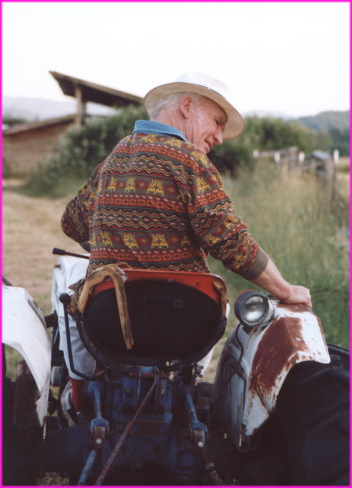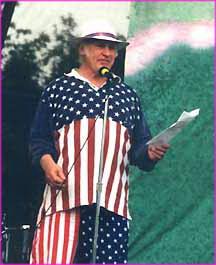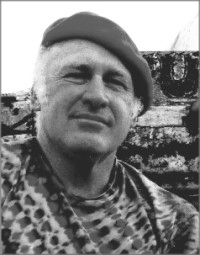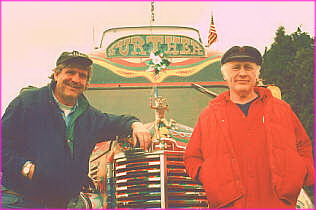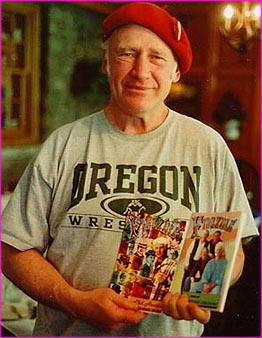Various Obituaries we have found on the Net
We do not have official permission to use these...Ssshh !!!
Tie-dyed mourners see Ken Kesey off to 'Furthur'
EUGENE, Oregon (Reuters) -- The mourners wore purple beads and tie-dyed shirts, crazy-quilt coats and paisley skirts; they laughed and sang and cried, saying farewell Wednesday to Ken Kesey, their friend and fellow prankster.
Out front of the McDonald Theatre in downtown Eugene sat a psychedelic bus, painted in all the colors of the rainbow, the latest version of "Furthur," the bus that crossed the United States in 1964 and sparked a cultural revolution.
Inside, center stage as was his custom, Kesey lay in a paisley-colored coffin draped in gold lame and bathed in purple light, soaking up the adoration of the 1,000 people jammed into the old theater. A hippie impresario and best-selling author, filmmaker and actor, farmer and teacher, Kesey died Saturday at age 66 from complications following a cancer operation. His multimedia memorial service included a taped benediction from the Grateful Dead, a video tribute, music from one of his plays and a rambling eulogy titled "Let's Make This Short" from his neighbor and fellow Merry Prankster, Ken Babbs. "We came of age in the time of Sputnik, but we were the astronauts of inner space," Babbs declared. "We are now and always have been the minority, but we will save the world.
"That was Kesey's goal -- to save the world," he smiled. Kesey, author of "One Flew Over the Cuckoo's Nest," "Sometimes a Great Notion" and other novels, essays and magazine articles, was buried on his farm in nearby Pleasant Hill, next to his son, Jed, who died in a van wreck in 1984.
As Babbs walked onto the stage to deliver the eulogy, he knocked twice on the lid of the coffin. Two knocks came back, causing first a stir then a laugh from the crowd, which spilled into the aisles and the lobby of the theater.
Babbs said he had known Kesey for 43 years, meeting him at a prestigious creative writing program at Stanford University. In the early 60s, Babbs went into the Marines, while Kesey worked in a mental hospital, an experience that provided the inspiration for "Cuckoo's Nest."
"I got out OK in 1964, got off the helicopter and onto the bus," Babbs said. The bus was "Furthur," so named and misspelled by LSD king Stanley Owsley, and on it went the Merry Pranksters, Kesey's friends and cohorts, for a ride across the country chronicled in Tom Wolfe's "Electric Kool-Aid Acid Test."
"It's important to know what a prank is," Babbs said, consulting a sheaf of crumpled notes. "Kesey defined it as something that doesn't hurt anyone. It has to be illuminating and it has to be funny.
"It's been proven that in the insane situation, the only sane response is to act crazy," he added. There were many tearful eyes at the service, held in a theater restored with the help of Kesey and his son Zane, 40, and aimed at putting some new life into the moribund downtown section of Eugene. In the crowd were several former members of the Grateful Dead, the rock band that often included Kesey on the stage; members of Kesey's family, including his wife and three children; community members, especially from his alma mater, the University of Oregon; former students, and hundreds of strangers he touched through his actions. "Kesey always said, 'It's not the destination that's important, it's the journey'," Babbs said.
From Jorma Kaukonen
Saturday, November 10, 2001 Meigs County, Ohio
Vanessa just called me from Racine up on the River and said that she heard on NPR that Ken Kesey had just died. If it weren't for Ken I probably would never have joined the Jefferson Airplane. When I went to sit in with the then nameless band he stopped by with an echoplex and had me plug my guitar through it. The electronic voices that came out of my speaker that day informed me that maybe Rock 'n' Roll might be fun.
Ken was not a close friend... we weren't bros, but he was an undeniable part of my past... a part of my generation's past. One Flew Over The Cuckoo's Nest is one of those books that seems as if it should have always been with us... an eternal classic. And of course there is Further on down the road, getting on the bus... that whole moment that seems to recall the Sixties in a brilliant flash.
The last time I saw him was in 1996 when the Furthur Festival played in Eugene and he jumped on stage in his American Flag getup and sang Gloria! There is a picture of this event in our workshop at the Fur Peace Ranch.
He is gone and time is moving on. My two year old nephew, while contemplating the concept of death reflected, 'When someone dies, he goes to God's House to visit Marlo.' Marlo was my old Bull Terrier who died almost three years ago. Well, this could be true... and if it is, Marlo is giving him a hearty lick and three full throated Roos. I can hear it now...
Roo...roo...rooo
Rest in peace Ken! We'll miss your presence but your spirit will endure!
Kesey goes out in proper tie-dye
Thursday, November 15, 2001
By M.L. LYKE SEATTLE POST-INTELLIGENCER REPORTER
EUGENE, Ore. -- Black or tie-dye? That was the fashion question at yesterday's multimedia memorial to the Merriest Prankster, the Impromptu Impresario, the Great Northwest Novelist and master of Now-ism, Ken Kesey, who went to his grave in a casket painted in psychedelic swirls of neon color.
Ray Sewell chose tie-dye for the service, a story-filled sendoff that drew a capacity crowd at the 800-seat McDonald Theater in Eugene.
"I decided to come as I am," said Sewell, one of the original Merry Band of Pranksters who tripped across the country with Kesey in the free-wheeling '60s Day-Glo bus "Furthur," made famous in Tom Wolfe's "The Electric Kool Aid Acid Test."
The graying, pony-tailed Prankster, with a bee's nest beard, tie-dye T, black jeans with red suspenders and a button given him by Kesey that read "High Pride," was teary-eyed as he recalled his last visit with Kesey Saturday at Sacred Heart Medical Center in Eugene, following surgery for cancer of the liver. Kesey was just 66. "He looked tired, worn-out. He had given everything, right to the last thought, right to the last flash."
Sewell, who moved from San Francisco to take part in the alternative culture that took root on the Kesey farm, shared hugs and stories with friends of "the tribe" who gathered in his eatery/diner Chez Ray's, prior to the noontime service. He reminisced about watching football games with Kesey, a pot of chili on the stove, wieners in the microwave and a cigar box of marijuana at hand. He remembered all the potlucks in Kesey's barn that turned into rehearsals for art performances. He remembered endless laughter. It was like a chant, he said. "You never knew what would happen with Ken. It was a constant stream of uncertainty."
Crowds began gathering outside the McDonald Theater two hours before the service, organized by Kesey kin. Outside were pictures from Kesey's multifaceted life: the pensive young writer of "Sometimes a Great Notion" and "One Flew Over the Cuckoo's Nest" with pen to mouth; Kesey as farmer, pitchfork in hand, red bandana around head; Kesey with grandkids, with Pranksters, with wife, Faye, his high-school sweetheart.
Many in attendance had driven hundreds of miles to pay their respects to a man who not only made art, but lived it. "He inspired me in many ways," said John Goldman, a computer consultant from Seattle who drove to Eugene with a picture of his own '60s bus, "Our Annex," on the dashboard. "It's like Ken said, 'You're either on the bus or you're off it.'"
The first speaker was the president of the University of Oregon, Dave Frohnmayer, who wore a traditional suit, with Jerry Garcia tie. He remembered Kesey as a stern disciplinarian in the writing classes he taught at the school, but a gentle-hearted man who sent him a box of books engraved with a dip of his "psychedelic pen" when Frohnmayer's daughter was diagnosed with fanconi anemia.
"He would be less worried about being a great man than a good man," Frohnmayer said, to a theater full of nodding heads, dampened sniffles and sighs.
Sterling Lord, Kesey's New York literary agent since the '60s, recalled the day when the leader of the Merry Pranksters finally arrived with bus in the Big Apple and called him. "He said, 'Sterling, when we hit New York, the city just rolled over on its back and purred.'"
A video presentation on large screen brought Kesey to life, performing as a hellfire-and-brimstone preacher in a Eugene production. "Please bow your heads in disbelief," Kesey told his audience. As he launched into "Shall we gather at the river?" the crowd at McDonald Theater joined in, under the sway of the larger-than-life figure on screen.
The master of Now was temporarily back in the moment..
Prankster Ken Babbs, who first met Kesey in writing class at Stanford University and joined in all his adventures, jumped on stage, patted the coffin and launched into tale after tale. He described rounding up recruits for the bus: "We were the astronauts of inner space." He described lying around on the floor with Kesey, microphones to mouth, lights off, making up novels beginning to end. He talked about the festivals Kesey organized, the pranks he played, the piles of manuscripts he left behind.
Though many now criticize the glorification of drugs in the '60s, Babbs declared the '60s, psychedelia, love and peace still alive. "Spread goodness!" said the grinning Prankster in the fringed leather vest.
After a tearful singing of "Amazing Grace," and an eloquent reading from "Sometimes a Great Notion," pallbearers carried the psychedelic casket down the aisles of the old theater to the street, where Furthur II, the latter-day knockoff of the original bus, waited in all its painted glory, with mandalas and doves, an oo-oga horn and a jester hood ornament.
As the body departed for a private service at the family farm, visitors clumped outside to cheer, some waving a memorial service program with Kesey's words at the bottom:
"The answer is never the answer. What's really interesting is the mystery. If you seek the mystery instead of the answer, you'll always be seeking." |
